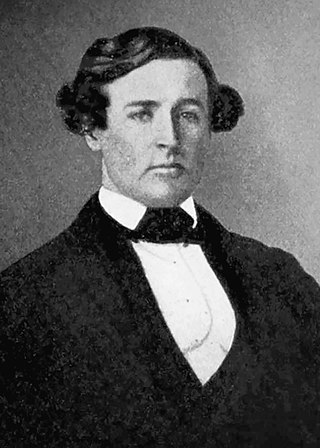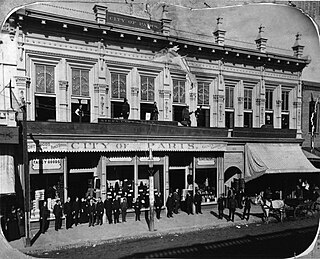Related Research Articles
Frankfort may refer to:

There have been Jewish communities in the United States since colonial times, with individuals living in various cities before the American Revolution. Early Jewish communities were primarily Sephardi composed of immigrants from Brazil, Amsterdam, or England.

The Simon Wiesenthal Center (SWC) is a Jewish human rights organization established in 1977 by Rabbi Marvin Hier. The center is known for Holocaust research and remembrance, hunting Nazi war criminals, combating anti-Semitism, tolerance education, defending Israel, and its Museum of Tolerance.
Chuts is the name applied to Jews who immigrated to London from the Netherlands during the latter part of the 19th century. They typically came from Amsterdam and practised trades they had already learned there, most notably cigar-, cap- and slipper-making.

Henry Mellus served as the eighth Mayor of Los Angeles from May 9, 1860, to December 26, 1860. He was a successful California businessman.

Marvin Hier is the dean and founder of the Simon Wiesenthal Center, its Museum of Tolerance and of Moriah, the center's film division.
Alexander SuslinHaKohen was a prominent 14th century rabbinic authority born in Erfurt, Germany, and one of the most important Talmudists of his time. He was rabbi first in Cologne and Worms, and then moved to Frankfort-on-the-Main. He authored Sefer HaAguddah, a halakhic work which was highly regarded by later rabbinic authorities. He was killed in the Erfurt massacre of 1349 during the Black Death era massacres of hundreds of Jewish communities throughout Europe.
Los Angeles Street, originally known as Calle de los Negros or Alley of the Black People, is a major thoroughfare in Downtown Los Angeles, California, dating back to the origins of the city as the Pueblo de Los Ángeles.

David W. Alexander was an early California politician and pioneer in Los Angeles County, California. He was on the Board of Supervisors in 1853 and 1854, and in 1855 he was elected the third sheriff for the county.

Jews in New York City comprise approximately 9 percent of the city's population, making the Jewish community the largest in the world outside of Israel. As of 2016, 1.1 million Jews lived in the five boroughs of New York City, and over 1.75 million Jews lived in New York State overall.

Francis Mellus was a Los Angeles County Supervisor and a successful California business man.

Jacob William Davis was an American tailor of Jewish origin who is credited with inventing modern jeans. Growing up in Russian Empire, he emigrated to the United States as a young man and spent some time in Canada as well. He invented jeans by using sturdy cloth and rivets to strengthen weak points in the seams, and partnered with Levi Strauss to mass-produce them.

Solomon Lazard, also known as S. Lazard, (1827–1916) was an entrepreneur in 19th century Los Angeles, California, a member of the city council there in 1854, and founder of S. Lazard & Co.
Felix Signoret (1825–1878) was a member of the Common Council, the governing body of the city of Los Angeles, and also of the Los Angeles County Board of Supervisors in the 19th century. He was the leader of a vigilante gang that carried out a lynching of a reputed murderer in 1863.

Alexander Bell (1801–1871) was a Los Angeles merchant both before and after that city became a part of the United States. He was elected to the first Los Angeles Common Council, the city's governing body, on July 1, 1850, but resigned on September 26 of that year.
Henry Wartenberg was a merchant and civic leader in Los Angeles, California, during the 19th century. He was the first president of the city's first volunteer fire department, in 1868–69, and a member of the Los Angeles Common Council, the governing body of the city, from 1868 to 1870.

Jews in Los Angeles comprise approximately 17.5 percent of the city's population, and 7% of the county's population, making the Jewish community the largest in the world outside of New York City and Israel. As of 2015, over 700,000 Jews live in the County of Los Angeles, and 1.232 million Jews live in California overall. Jews have immigrated to Los Angeles since it was part of the Mexican state of Alta California, but most notably beginning at the end of the 19th century to the present day. The Jewish population rose from about 2,500 in 1900 to at least 700,000 in 2015. The large Jewish population has led to a significant impact on the culture of Los Angeles. The Jewish population of Los Angeles has seen a sharp increase in the past several decades, owing to internal migration of Jews from the East Coast, as well as immigration from Israel, France, the former Soviet Union, the UK, South Africa, and Latin America, and also due to the high birth rate of the Hasidic and Orthodox communities who comprise about 10% of the community's population.

Maurice Kremer (1824–1907) was an American businessman and civil servant.

City of Paris was a dry goods store and eventually Los Angeles' first department store, operating from the 1850s through 1897, first as Lazard & Kremer Co., then Lazard & Wolfskill Co., then S. Lazard & Co., then with the store name City of Paris operated by Eugene Meyer & Co., then by Stern, Cahn & Loeb. It should not be confused with the much more famous City of Paris store of San Francisco, or the Ville de Paris department store of Los Angeles, of Mr. A. Fusenot, which was a spinoff of San Francisco's "City of Paris".

Hellman, Haas & Co was one of the first grocers in early Los Angeles, a partnership of Abraham Haas and Herman W. Hellman), and the predecessor company of Smart & Final. Located in the 1880s and 1890s at 218-224 N. Los Angeles Street, immediately south of Mellus Row. This was the heart of the city's business district in the 1870s and 1880s. The store sold "everything from drugs to explosives." Food staples were sold by weight, in bulk. The store was one of seven names in the city's first phone directory. In the 1880s, Herman Baruch, who was married to Abraham Haas' niece, Jeanette Meertief, and his brother, Jacob Baruch, who was married to another niece, Jeanette Weiler, bought out Herman Hellman when Hellman took the position of manager of the Farmers and Merchants Bank, a bank which grew out of Hellman's being so trusted that early Angelenos entrusted their valuables to him for safekeeping. In 1889, the company name was changed to Haas, Baruch & Co., and by the turn of the 20th century the store was the growing city’s most dominant wholesale grocery business.
References
- 1 2 3 "Jacob Frankfort & the First Eight Jewish Pioneers of Los Angeles". Jewish Museum of the American West. Retrieved 28 February 2013.